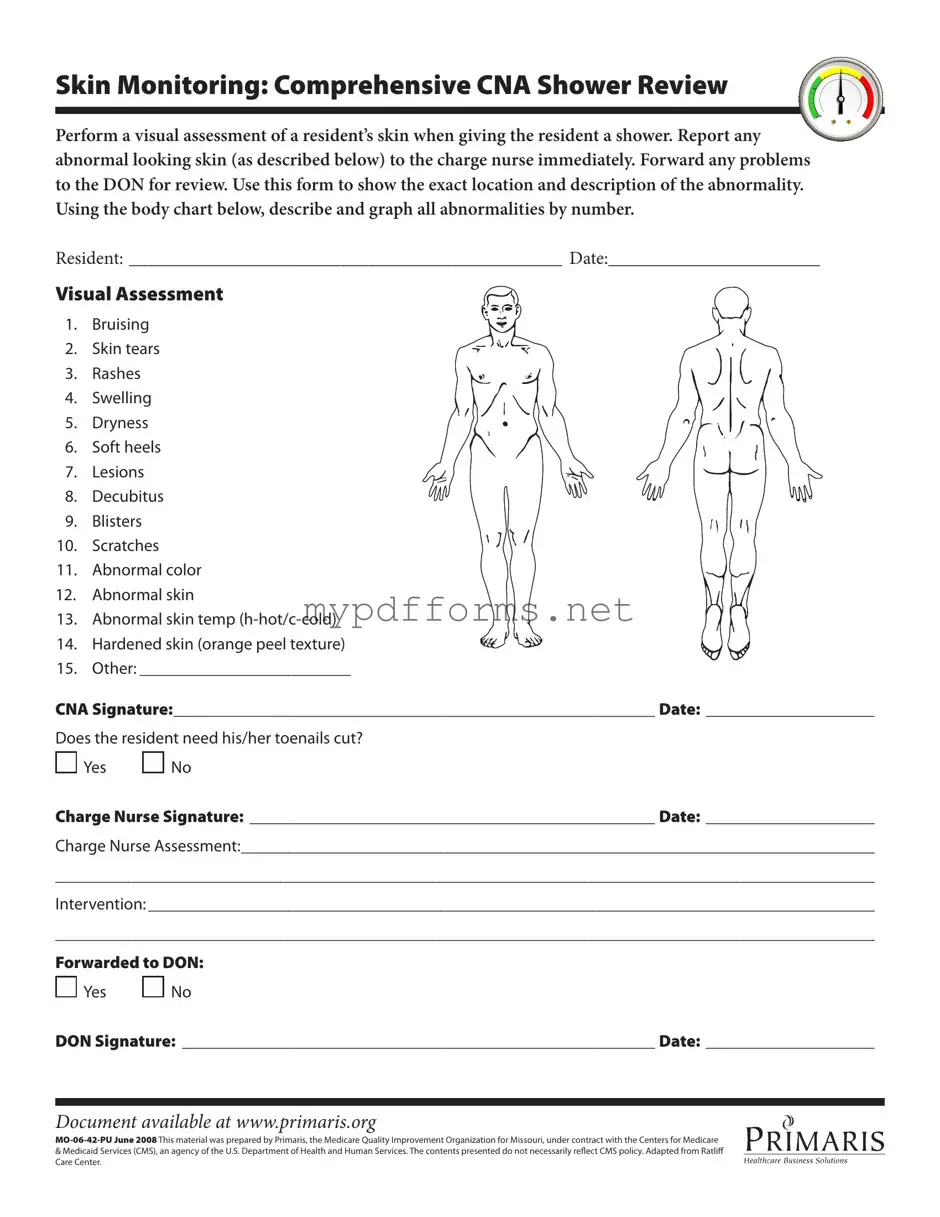The CNA Shower Sheets form is similar to the Incident Report form, which is commonly used in healthcare settings to document any unusual occurrences involving patients. Both documents require detailed descriptions of observed conditions, ensuring that any abnormalities are noted and reported to the appropriate personnel. The Incident Report focuses on events such as falls or medication errors, while the CNA Shower Sheets specifically monitor skin conditions during bathing. Both forms aim to promote patient safety and facilitate communication among staff members regarding patient care.
Another comparable document is the Patient Assessment form, which serves to evaluate a resident's overall health status. This form includes sections for vital signs, medical history, and current health issues. Like the CNA Shower Sheets, it emphasizes the importance of thorough observation and documentation. Both documents require healthcare professionals to record specific findings, enabling a comprehensive understanding of the patient’s condition and informing subsequent care decisions.
The Care Plan form is also similar, as it outlines the strategies and interventions tailored to meet a resident's needs. This document, like the CNA Shower Sheets, requires input from various healthcare providers to ensure a holistic approach to care. While the Care Plan focuses on long-term goals and interventions, the CNA Shower Sheets provide immediate observations that can influence daily care practices, thereby enhancing the overall quality of care.
Similarly, the Skin Assessment form serves to monitor skin integrity over time. This document often includes a checklist of skin conditions and a section for documenting changes. The CNA Shower Sheets share this focus on skin health, emphasizing the importance of regular assessments during bathing. Both forms aim to identify potential issues early, allowing for timely interventions to prevent further complications.
The Medication Administration Record (MAR) is another document that bears similarities to the CNA Shower Sheets. While the MAR tracks medications administered to patients, it also requires staff to observe and document any side effects or reactions. Both forms prioritize accurate reporting and communication among healthcare providers, ensuring that any changes in a resident’s condition are promptly addressed.
In addition, the Daily Progress Notes are akin to the CNA Shower Sheets in that they record observations and updates on a resident’s condition. These notes provide a comprehensive account of a patient’s status throughout the day, including any changes in skin condition or other health indicators. Both documents serve as vital communication tools that help maintain continuity of care among staff members.
The Resident Care Log is another similar document, focusing on daily interactions and care provided to residents. This log captures various aspects of care, including personal hygiene and skin assessments. The CNA Shower Sheets specifically target skin monitoring during showers, while the Resident Care Log encompasses a broader range of daily activities, yet both emphasize the importance of documentation for effective patient care.
To effectively handle property transfers in Pennsylvania, understanding the Quitclaim Deed form is essential, as it allows for a seamless ownership change without title warranties. This document serves as a vital tool when ensuring clarity in such transactions, highlighting the importance of accurate documentation for all parties involved. For those interested in starting this process, it's helpful to utilize resources like quitclaimdocs.com/fillable-pennsylvania-quitclaim-deed/, which provide guidance on filling out the requisite forms correctly.
The Fall Risk Assessment form also shares a connection with the CNA Shower Sheets. Both documents are used to evaluate specific risks associated with patient care. While the Fall Risk Assessment identifies factors that may contribute to falls, the CNA Shower Sheets concentrate on skin integrity during bathing. Each document plays a crucial role in promoting patient safety by identifying potential issues that require intervention.
Lastly, the Vital Signs Record is comparable to the CNA Shower Sheets as both documents require regular monitoring of patient conditions. The Vital Signs Record focuses on physiological measurements, while the CNA Shower Sheets document skin conditions during bathing. Both forms are essential for tracking changes over time and ensuring that any emerging health concerns are addressed promptly.
